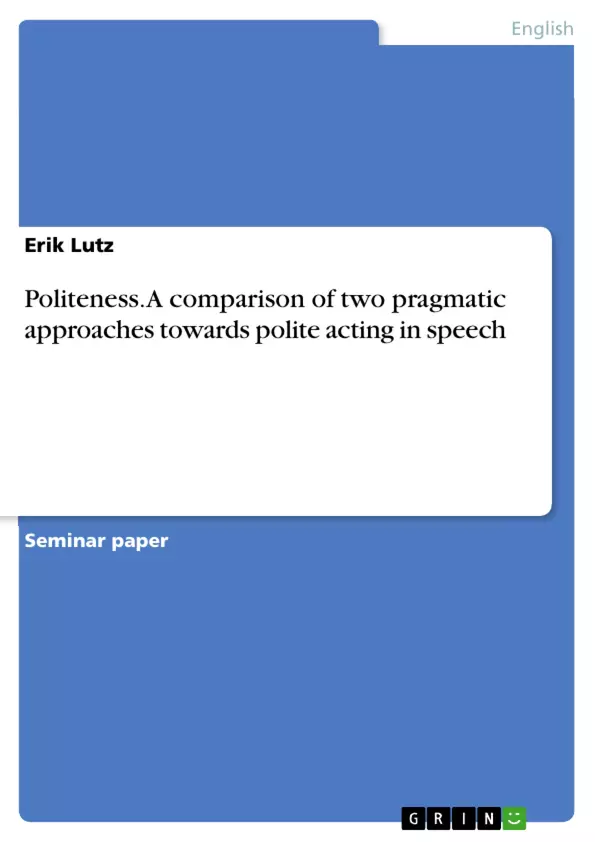This term paper is concerned with the question of whether or not two pragmatic approaches to language can be adapted to the phenomenon of politeness and be combined under certain aspects. The specific question is: Can Penelope Brown and Stephen C. Levinson’s model of politeness completely be described through the terminology and perspective of Grice’s?
I will therefore, in a first step, compare both models under these aspects and then try to combine them. Depending on to what degree this can be done, I shall afterwards explain the differences that hinder a complete merging, if they exist. In a second step, I will adapt the new knowledge exemplarily to a corpus and repeat the comparison deductively on a practical level.
Inhaltsverzeichnis (Table of Contents)
- Introduction
- Thesis
- Grice's Maxims and his cooperation principle
- Brown and Levinson's face-threatening acts
- Merging both in theory
- Cooperative principle
- Maxims
- Conclusion
- Explanatory statement regarding the corpus
- Method
- Exemplary practical proof
- Arthur: “[...] Ron, get out of the kitchen. We're all hungry.\" (28f)
- Dumbledore: \"I'd like to make an announcement. [...]\" (46f).
- Seamus: \"Can I have a go, Harry? After you, of course.\" (138) ...
- Conclusion
Zielsetzung und Themenschwerpunkte (Objectives and Key Themes)
This term paper aims to investigate whether two pragmatic approaches to language can be applied to the phenomenon of politeness and combined under certain aspects. The specific question is: Can Penelope Brown and Stephen C. Levinson's model of politeness be completely described through the terminology and perspective of Grice's? The paper will compare both models and attempt to combine them. Depending on the degree to which this is possible, the paper will then explore the differences that hinder a complete merging, if any exist. In a second step, the new knowledge will be applied exemplarily to a corpus and the comparison will be repeated deductively on a practical level.
- Politeness in language
- Pragmatic approaches to politeness
- Grice's Cooperative Principle and Maxims
- Brown and Levinson's face-threatening acts
- Merging of pragmatic theories
Zusammenfassung der Kapitel (Chapter Summaries)
The introduction presents the objective of the term paper, which is to examine whether two pragmatic approaches to politeness can be merged. The thesis chapter outlines the main arguments of both Grice's Cooperative Principle and Brown and Levinson's politeness theory. Grice's theory focuses on conversational implicature, while Brown and Levinson's theory centers on face-threatening acts. Both theories offer possibilities to imply nonliteral meaning into utterances. Chapter 3 elaborates on Grice's four conversational maxims of Quantity, Quality, Relation, and Manner. The maxim of Quantity requires speakers to be as informative as required. The maxim of Quality mandates that speakers only utter true and evident statements. The maxim of Relation suggests that utterances should be context-fitting, and the maxim of Manner encourages speakers to be clear, unambiguous, brief, and orderly. Grice's Cooperative Principle is the overarching principle that governs these maxims. It assumes that speakers will act cooperatively in a conversation.
Schlüsselwörter (Keywords)
The main keywords and focus topics of the text include politeness, pragmatics, conversational implicature, face-threatening acts, Grice's Cooperative Principle, Brown and Levinson's politeness theory, conversational maxims, and face. The text explores the application and potential merging of these concepts in the analysis of politeness in language.
- Quote paper
- Erik Lutz (Author), 2015, Politeness. A comparison of two pragmatic approaches towards polite acting in speech, Munich, GRIN Verlag, https://www.grin.com/document/335445



